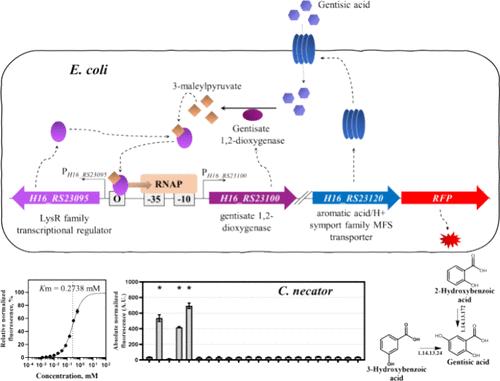当前位置:
X-MOL 学术
›
Anal. Chem.
›
论文详情
Our official English website, www.x-mol.net, welcomes your
feedback! (Note: you will need to create a separate account there.)
Maleylpyruvic Acid-Inducible Gene Expression System and Its Application for the Development of Gentisic Acid Biosensors
Analytical Chemistry ( IF 6.7 ) Pub Date : 2024-11-15 , DOI: 10.1021/acs.analchem.4c03906 Ingrida Kutraite, Ernesta Augustiniene, Naglis Malys
Analytical Chemistry ( IF 6.7 ) Pub Date : 2024-11-15 , DOI: 10.1021/acs.analchem.4c03906 Ingrida Kutraite, Ernesta Augustiniene, Naglis Malys

|
Gentisic acid is a secondary plant metabolite, known for its health benefits, not only widely used as a supplement but also implicated as a potential biomarker for cancer-associated metabolism alterations. To advance bioproduction and detection of this compound or its derivatives, cell-based approaches have become of interest in recent years. However, the lack of tools for high-throughput gentisic acid monitoring and compound-metabolizing organism screening limits the progress in this area. Here, we analyzed the gene cluster responsible for gentisic acid metabolism in Cupriavidus necator H16. The transcriptional regulator GtdR-based inducible gene expression system CnGtdR/PgtdA was elucidated, showing that it was activated when C. necator cells were subjected to gentisic acid. Subsequently, a 3-maleylpyruvic acid was identified as a primary inducer for this inducible system. Furthermore, genes gtdA and gtdT, encoding for gentisate 1,2-dioxygenase and MFS transporter, were shown to be essential for inducible system activation in the presence of gentisic acid with GtdA enabling conversion of this phenolic acid into the inducer. The CnGtdRAT/PgtdA-based inducible system was employed to develop a whole-cell biosensor for the intracellular and extracellular detection of gentisic acid. The potential of the 3-maleylpyruvic acid-inducible system was demonstrated by its application in metabolic pathway research, detection of highly unstable 3-maleylpyruvic acid, and development of biosensors for the intracellular or extracellular determination of gentisic acid. In addition, the utility of the biosensor was emphasized by its application for detection of gentisic acid as a potential biomarker for cancer in urine samples.
中文翻译:

马来基丙酮酸诱导型基因表达系统及其在龙胆酸生物传感器开发中的应用
龙胆酸是一种次生植物代谢物,以其健康益处而闻名,不仅被广泛用作补充剂,而且还被认为是癌症相关代谢改变的潜在生物标志物。为了促进这种化合物或其衍生物的生物生产和检测,近年来基于细胞的方法引起了人们的兴趣。然而,缺乏高通量龙胆酸监测和化合物代谢生物体筛选的工具限制了该领域的进展。在这里,我们分析了 Cupriavidus necator H16 中负责龙胆酸代谢的基因簇。阐明了基于转录调节因子 GtdR/PgtdA 的诱导基因表达系统 CnGtdR/P gtdA,表明当 C. necator 细胞受到龙胆酸的影响时,它被激活。随后,一种 3-马来酰丙酮酸被鉴定为该诱导系统的主要诱导剂。此外,编码龙胆酸 1,2-双加氧酶和 MFS 转运蛋白的基因 gtdA 和 gtdT 被证明在龙胆酸存在下对于诱导系统激活至关重要,GtdA 使这种酚酸能够转化为诱导剂。采用基于 CnGtdRAT/PgtdA 的诱导系统开发用于龙胆酸细胞内和细胞外检测的全细胞生物传感器。3-马来基丙酮酸诱导系统的潜力通过其在代谢途径研究中的应用、高度不稳定的 3-马来酰丙酮酸的检测以及用于细胞内或细胞外龙胆酸测定的生物传感器的开发而得到证明。 此外,生物传感器在检测龙胆酸作为尿液样本中癌症的潜在生物标志物的应用强调了生物传感器的实用性。
更新日期:2024-11-16
中文翻译:

马来基丙酮酸诱导型基因表达系统及其在龙胆酸生物传感器开发中的应用
龙胆酸是一种次生植物代谢物,以其健康益处而闻名,不仅被广泛用作补充剂,而且还被认为是癌症相关代谢改变的潜在生物标志物。为了促进这种化合物或其衍生物的生物生产和检测,近年来基于细胞的方法引起了人们的兴趣。然而,缺乏高通量龙胆酸监测和化合物代谢生物体筛选的工具限制了该领域的进展。在这里,我们分析了 Cupriavidus necator H16 中负责龙胆酸代谢的基因簇。阐明了基于转录调节因子 GtdR/PgtdA 的诱导基因表达系统 CnGtdR/P gtdA,表明当 C. necator 细胞受到龙胆酸的影响时,它被激活。随后,一种 3-马来酰丙酮酸被鉴定为该诱导系统的主要诱导剂。此外,编码龙胆酸 1,2-双加氧酶和 MFS 转运蛋白的基因 gtdA 和 gtdT 被证明在龙胆酸存在下对于诱导系统激活至关重要,GtdA 使这种酚酸能够转化为诱导剂。采用基于 CnGtdRAT/PgtdA 的诱导系统开发用于龙胆酸细胞内和细胞外检测的全细胞生物传感器。3-马来基丙酮酸诱导系统的潜力通过其在代谢途径研究中的应用、高度不稳定的 3-马来酰丙酮酸的检测以及用于细胞内或细胞外龙胆酸测定的生物传感器的开发而得到证明。 此外,生物传感器在检测龙胆酸作为尿液样本中癌症的潜在生物标志物的应用强调了生物传感器的实用性。


















































 京公网安备 11010802027423号
京公网安备 11010802027423号